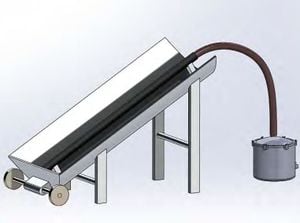No edit summary |
No edit summary |
||
| Line 1: | Line 1: | ||
{{OpenKnowHowManifest | {{OpenKnowHowManifest | ||
|manifest-date-created=2020-07-18 | |manifest-date-created=2020-07-18 | ||
|manifest-date-updated=2020-07- | |manifest-date-updated=2020-07-20 | ||
|manifest-author-name=Megan Moore | |manifest-author-name=Megan Moore | ||
|manifest-author-affiliation=Appropedia | |manifest-author-affiliation=Appropedia | ||
|manifest-author-email=info@appropedia.org | |manifest-author-email=info@appropedia.org | ||
|title=Solar autoclave | |title=Solar autoclave | ||
|description=A solar autoclave is a medical device that has a hotter and more highly pressurized chamber that sterilizes medical tools. To accomplish this, water is passively heated by the sun and the hot water is channeled through the chamber to increase the temperature, and hot steam from the heated water is used to increase the pressure inside the chamber. This device is useful in rural places that do not have access to typical autoclaves or experiences intermittent losses of electricity. | |||
|intended-use=Sterilizing medical equipment | |||
|keywords=Solar, passive solar, temperature, pressure, water, hot water, steam, sterilizination, medical equipment, autoclave, solar autoclave | |||
|contact-affiliation=Appropedia user | |contact-affiliation=Appropedia user | ||
|contact-appropedia-user=Yuke | |contact-appropedia-user=Yuke | ||
|made=No | |made=No | ||
|manifest-language=English | |||
|documentation-language=English | |||
|date-published=2013/07/20 | |date-published=2013/07/20 | ||
|sustainable-development-goal=SDG01 No poverty, SDG03 Good health and well-being, SDG07 Affordable and clean energy, SDG09 Industry, SDG10 Reduced inequalities, SDG11 Sustainable cities and communities, SDG12 Responsible consumption and production | |||
}} | }} | ||
[[category:solar]] | [[category:solar]] | ||
[[category:Health and safety]] | [[category:Health and safety]] | ||
Revision as of 02:52, 21 July 2020

Sterilizing medical instruments from disease-carrying organisms requires both heat and pressure. This is normally accomplished by 20 minutes in an autoclave, a pressurized steam chamber. In rural areas of the developing world such equipment is not readily available. They must send their used instruments away for sterilization or even if an autoclave is available, intermittent electricity service can hold up the process and delay needed medical procedures.
Northern Arizona University has developed a solar autoclave design to address those problems. Their prototype features a reflective parabolic trough that, when placed in the sun, heats water and channels steam into a pressure cooker. It is made from widely available materials that may not be a problem to find in many developing regions.
For more information see: Full report